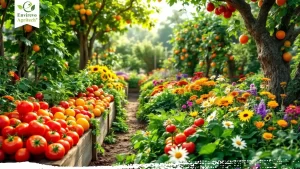Table of Contents
In today’s fast-paced world, where convenience often outweighs sustainability, it’s refreshing to find gardening methods that prioritize both. One such method that is turning heads in the world of permaculture and organic gardening is Hügelkultur. If you’re tired of back-breaking digging, constant fertilizing, and watering that never seems enough, it might be time to discover the incredible power of the Hügelkultur raised bed.
This centuries-old technique, with roots in Eastern European agricultural traditions, offers a no-dig, low-maintenance, and eco-friendly way to grow food. It promises abundant harvests while enriching your soil and conserving water. In this comprehensive guide, we’ll dive deep into what Hügelkultur is, how it works, how to build your own, and why gardeners everywhere are embracing it.
What Is Hügelkultur?
Hügelkultur (pronounced hyoo-gul-culture) is a German word that translates to “mound culture” or “hill culture.” It refers to a method of gardening that involves building raised beds filled with logs, branches, organic matter, and soil. The process utilizes the natural decomposition of wood and plant materials to create nutrient-rich, water-retentive garden beds.
Historically practiced by German and Eastern European farmers, Hügelkultur has been adapted into modern permaculture systems due to its ability to replicate natural forest-floor ecology. The concept is simple yet profound: bury logs and other biomass beneath your garden soil, then let nature do the rest.

Unlike traditional raised beds that require frequent soil amendments and watering, a Hügelkultur raised bed becomes a living, breathing ecosystem that nourishes your plants for years.
How Hügelkultur Works: The Science Behind the Soil
At the core of a Hügelkultur bed are large logs and branches. As these woody materials decompose, they release nutrients back into the soil, much like composting. The logs also act like a sponge, absorbing and retaining water, then gradually releasing it to plant roots during dry periods.
This internal water reservoir means your garden needs less irrigation—a huge benefit for areas facing water scarcity. Moreover, the decomposition process generates heat, which can extend your growing season in cooler climates.
The structure of a Hügelkultur bed improves over time. Initially, it may appear rough and uneven, but as the organic material breaks down, the mound settles and stabilizes. The microbial activity within the mound fosters rich biodiversity, encouraging beneficial fungi, bacteria, and invertebrates.
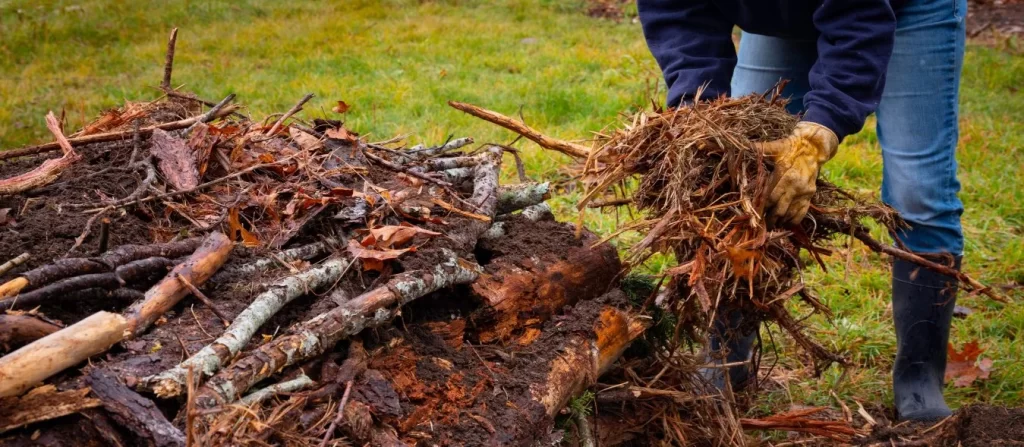
This self-sustaining cycle makes Hügelkultur an ideal solution for:
- Poor or compacted soils
- Sloped or erosion-prone land
- Areas with limited access to water
- Gardeners seeking low-maintenance systems
The Many Benefits of Hügelkultur Raised Beds
1. Water Conservation
The most celebrated benefit of Hügelkultur is its ability to retain moisture. The decaying wood acts as a reservoir, significantly reducing the need for frequent watering. This feature is especially advantageous in drought-prone regions or during hot summer months.
2. Improved Soil Fertility
As logs and organic matter break down, they release a steady stream of nutrients into the soil. This natural fertilization process can support plant growth for 5 to 10 years or more, depending on the materials used.
3. Enhanced Microbial Life and Soil Health
Decomposition fosters a healthy soil ecosystem rich in microbes and beneficial fungi. These organisms break down organic matter, improve soil structure, and boost plant immunity against diseases.
4. Minimal Weeding and Maintenance
The height and density of a Hügelkultur bed can discourage weed growth. Additionally, the no-dig approach preserves soil structure and reduces weed seed exposure.
5. Stormwater Management
According to the Oklahoma State University Extension, Hügelkultur beds can help manage stormwater runoff by slowing and absorbing rainfall. This makes them excellent additions to eco-landscaping or rain garden designs.
6. Waste Reduction and Recycling
Gardeners can repurpose yard waste, such as fallen branches, leaves, grass clippings, and even kitchen scraps. Instead of sending these materials to a landfill, Hügelkultur turns them into productive resources.
7. Extended Growing Season
The heat produced by microbial activity during decomposition can warm the soil earlier in spring and later into fall. This thermal mass effect gives your plants a head start and a longer harvest window.
Types of Hügelkultur Beds
- In-ground Hügelkultur without border
- In-ground Hügelkultur with wood border
- In-ground Hügelkultur with stone border
- Above-ground Hügelkultur without border
- Above-ground Hügelkultur with wood border
- Above-ground Hügelkultur with stone border
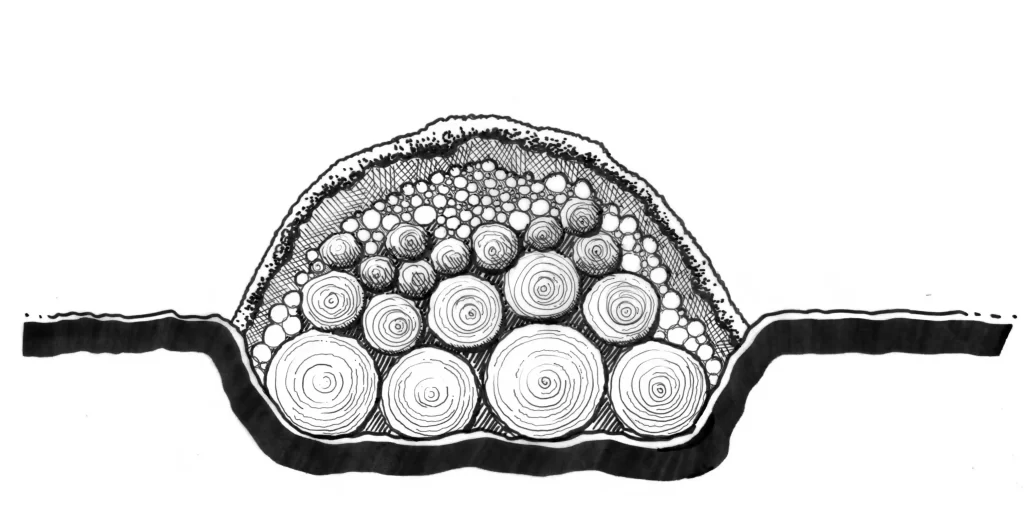
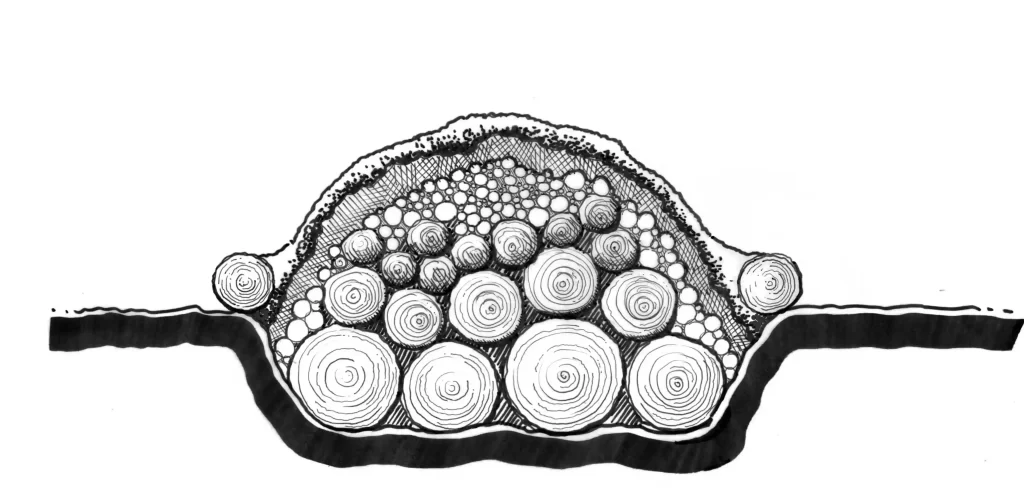
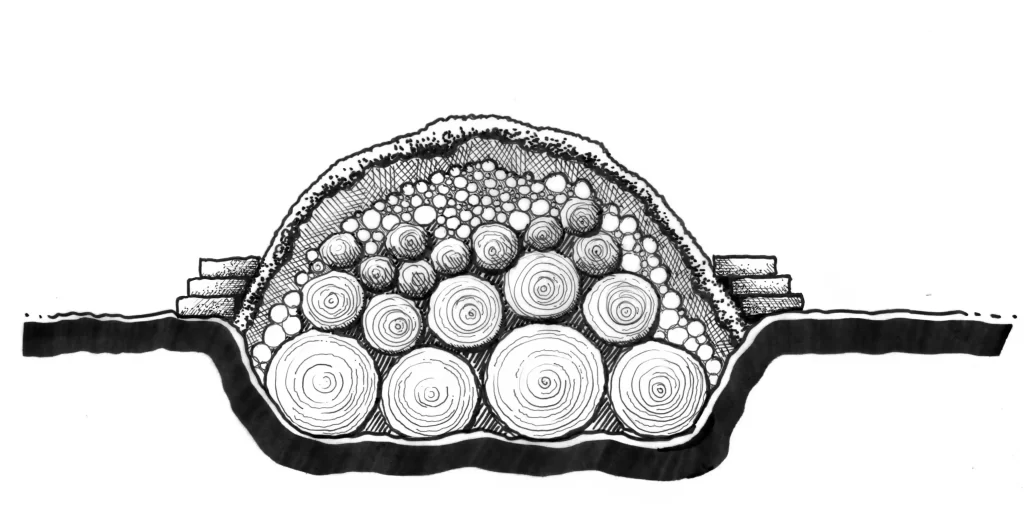

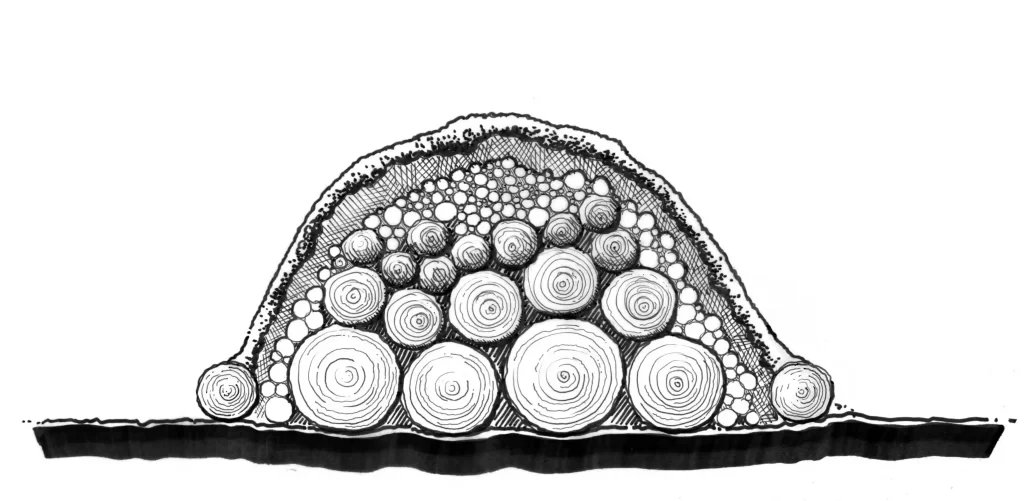
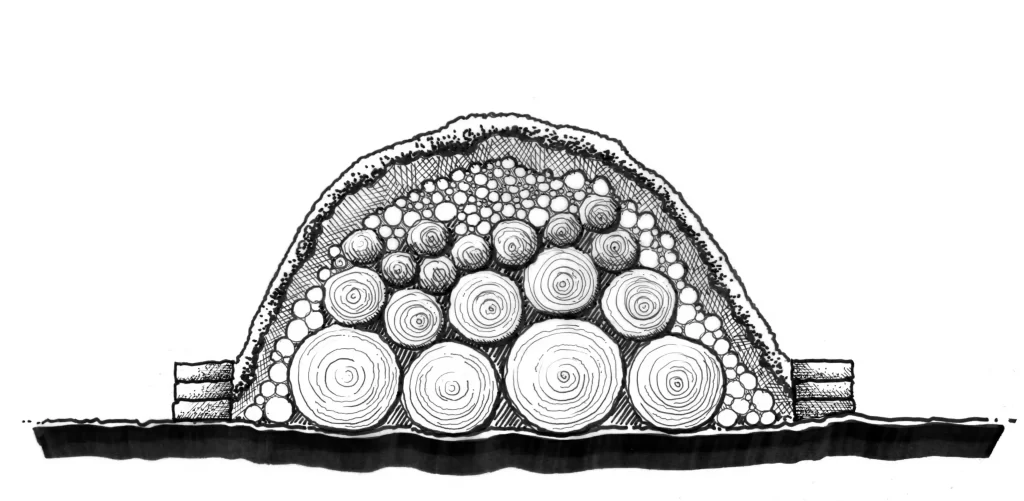
What to Put in a Hügelkultur Bed: Material Selection Guide
Creating an effective Hügelkultur raised bed depends heavily on selecting the right materials and layering them correctly. Think of it as building a lasagna garden with a woody core.
Base Layer: Logs and Branches
- Use rotted or semi-rotted hardwoods like maple, alder, birch, apple, and oak. These decompose slowly and provide long-term structure.
- Avoid woods with toxins or allelopathic properties, such as black walnut, cedar, or eucalyptus.
- Cut logs to manageable lengths and stack them to form the mound’s base.
Middle Layer: Finer Organic Matter
- Add twigs, leaves, straw, grass clippings, cardboard, and shredded paper.
- This layer acts as a transition zone, filling gaps and encouraging decomposition.
- Avoid thick layers of green materials that can compact or smell.
Top Layer: Compost and Soil
- Cap the mound with 6–8 inches of compost mixed with native soil.
- This is your planting layer, where seeds and seedlings will thrive.
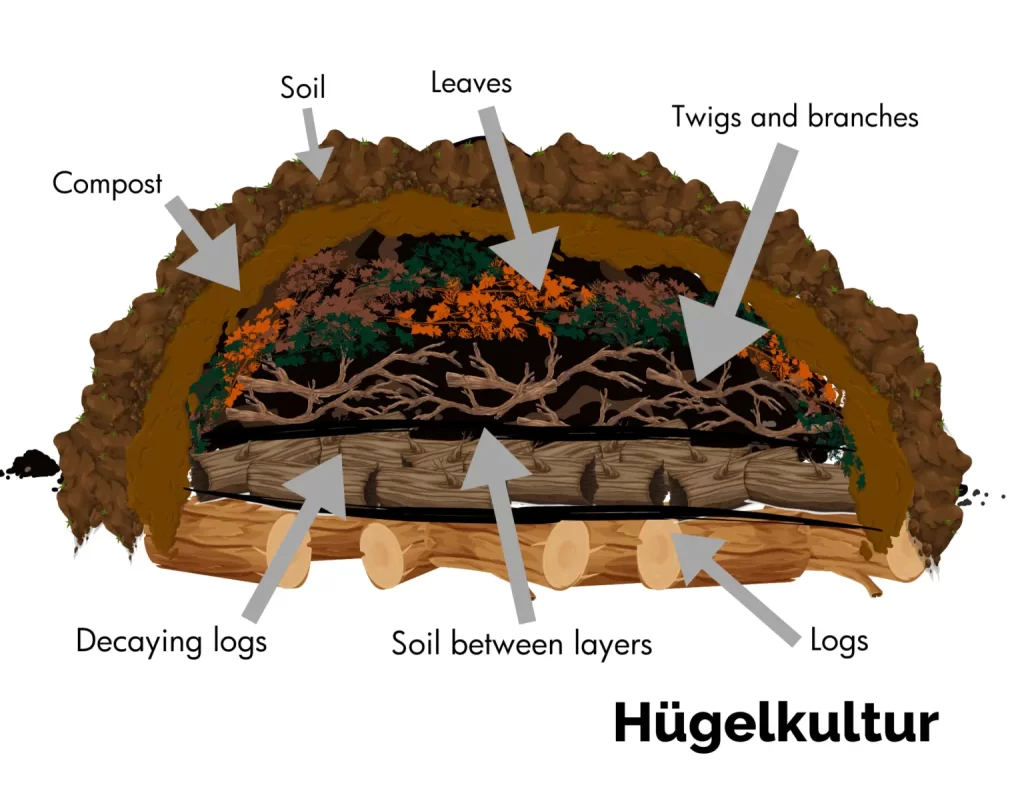
The key is balance: combine carbon-rich (brown) materials like wood and paper with nitrogen-rich (green) matter such as grass and food scraps. This mimics composting dynamics and speeds up decomposition.
Step-by-Step Guide to Building a Hügelkultur Raised Bed
- Step 1: Choose a Site: Pick a sunny location with good drainage. Consider wind exposure and access to water. If using Hügelkultur for stormwater control, choose a low-lying or sloped area.
- Step 2: Clear and Prepare the Ground: Remove sod or weeds. Dig a shallow trench (6-12 inches) if building a partially buried bed. This stabilizes the mound and improves moisture retention.
- Step 3: Lay the Woody Base: Arrange logs and thick branches horizontally in the trench or on the ground. Stack them to the desired height, typically 2 to 6 feet.
- Step 4: Add Intermediate Organic Layers: Fill gaps with smaller branches, sticks, leaves, and compostable materials. Tamp them down to reduce air pockets.
- Step 5: Add Soil and Compost: Top the mound with a mix of compost and topsoil. Aim for a smooth, slightly rounded surface to prevent erosion.
- Step 6: Plant and Mulch: Plant seeds or transplants immediately. Add mulch to retain moisture and protect against weeds.
- Step 7: Water and Monitor: Water the mound thoroughly after construction. Monitor soil moisture during the first season, as decomposition absorbs water initially.
Common Mistakes to Avoid When Building Hügelkultur Beds
Despite its simplicity, Hügelkultur comes with a learning curve. Avoid these common pitfalls to ensure your bed thrives:
- Using the Wrong Wood: Freshly cut or green wood can tie up nitrogen, starving your plants. Use aged or rotting logs whenever possible. Also, avoid allelopathic woods like black walnut, which inhibit plant growth.
- Overpacking the Bed: Tightly compacting the materials prevents airflow and slows decomposition. Layer materials loosely to maintain oxygen flow and microbial activity.
- Not Adding Enough Soil: A thin top layer of soil may wash away or fail to support plant roots. Ensure a robust layer (6–8 inches) of topsoil mixed with compost for optimal growth.
- Planting Too Soon: Allow the bed to settle for a few weeks after construction, especially if using a lot of green materials. Initial decomposition can generate excess heat or nitrogen lock-up.
- Ignoring Moisture Management: Though Hügelkultur beds are water-retentive, the first season may require extra watering as the mound stabilizes. Don’t assume it’s self-sufficient from day one.
Is Hügelkultur Right for Your Garden?
Hügelkultur is a versatile solution, but it may not be ideal for every gardener. It excels in:
- Dry or drought-prone climates
- Backyards with poor soil or drainage issues
- Large properties with access to woody debris
- Permaculture farms and sustainable landscapes
It may pose challenges in:
- Small urban gardens with limited space
- Areas with heavy clay or saturated soil
- Gardens where aesthetics require uniform beds
Still, even on a small scale, you can apply Hügelkultur principles. Try a mini mound or raised bed version, or incorporate woody debris into traditional garden beds for improved fertility.
Final Thoughts: Grow More with Less
Hügelkultur isn’t just a gardening technique—it’s a philosophy that aligns with nature’s rhythms. By mimicking forest ecosystems, you create a self-sustaining, low-maintenance garden that nourishes itself while producing healthy, abundant crops.
If you’re ready to stop digging, watering constantly, and struggling with poor soil, Hügelkultur could transform your gardening experience. Whether you’re a seasoned homesteader or a backyard beginner, this ancient method can help you grow more with less effort.





